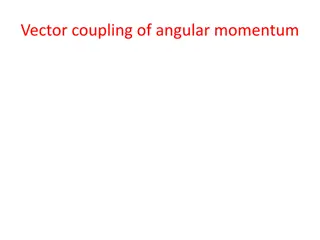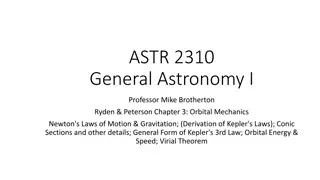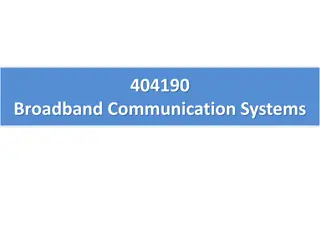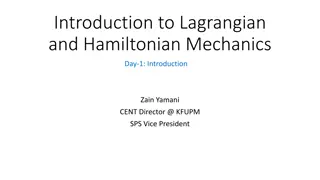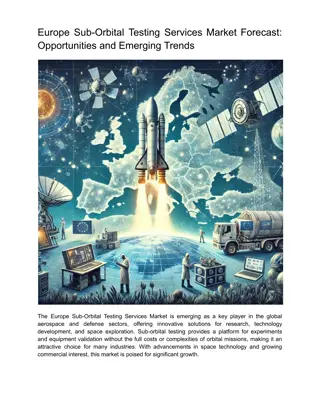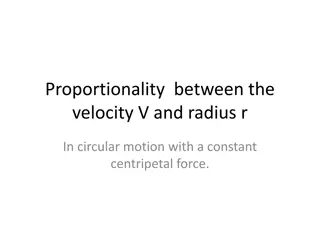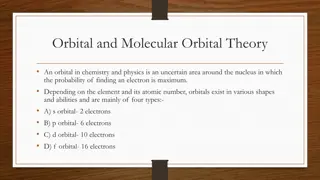Impacts of Thermosphere Contraction on Debris Accumulation and Orbital Capacity
Explore the effects of thermosphere contraction on debris accumulation and orbital capacity, as discussed in a workshop at Politecnico di Milano. Satellite observations reveal increasing COx levels, impacting the upper atmosphere's chemistry. The concern for space debris management is highlighted, e
2 views • 29 slides
Influence of Solar Activity and Orbital Motion on Terrestrial Atmosphere
Solar magnetic field reversal, wavelet spectral analysis, and proxies for solar activity index are discussed in relation to the joint effects of solar activity and solar orbital motion on the Earth's atmosphere. The study highlights the impact of solar cycles on terrestrial climate dynamics and temp
7 views • 16 slides
Orbits and Motion in Astrophysics
Explore the concept of orbits and motion in astrophysics, covering gravitational forces, planetary orbits, orbital speeds, and celestial phenomena like lunar eclipses. Delve into how objects move in space, the relationships between orbital speed, radius, and time period, and the dynamics of celestia
1 views • 14 slides
Chemistry Regents August 2022: Questions and Answers
Explore the answers to questions from the August 2022 Chemistry Regents exam, covering topics like electron configuration, orbital definition in the wave-mechanical model, and electron energy shells in atoms. Understand concepts such as the number of protons in an atom, orbital definitions, and elec
0 views • 167 slides
Crystal Field Theory in Chemistry
Crystal Field Theory (CFT) explains how electron orbital degeneracies, particularly d or f orbitals, are affected by a static electric field generated by neighboring anions. In CFT, the metal ion is considered positive while ligands are negative charges, leading to attractive and repulsive forces af
0 views • 13 slides
Angular Momentum in Quantum Mechanics
Exploring the concept of total angular momentum in quantum mechanics, which involves the quantization of orbital and spin angular momenta. The coupling of these vectors leads to the formation of total angular momentum, with implications for the behavior of single-electron systems like the hydrogen a
1 views • 16 slides
Quantum Mechanics: Illusion or Reality?
Delve into the fascinating realm of quantum mechanics with Prof. D. M. Parshuramkar as he discusses the contrast between classical and quantum mechanics. Discover how classical mechanics fails to predict the behavior of electrons in atoms and molecules, leading to the development of quantum mechanic
2 views • 70 slides
Orbital Mechanics: Kepler's Laws, Center of Mass, and Equation of Motion
Exploring the fundamental concepts in orbital mechanics including Kepler's Laws, center of mass calculations, and equations of motion for celestial bodies. Topics covered include the laws of planetary motion, center of mass reference frame, and the concept of reduced mass in celestial mechanics.
1 views • 15 slides
Orbital Dynamics: Kepler's Laws and Newtonian Gravity
Delve into the fascinating world of orbital dynamics as we explore Kepler's Laws and Newtonian Gravity. From understanding the elliptical orbits of planets around the Sun to uncovering the role of gravity in shaping celestial motion, this journey will illuminate the fundamental principles governing
0 views • 18 slides
Electron Configuration and Quantum Numbers in Chemistry
Explore the concept of electron configurations, quantum numbers, and orbital filling rules in chemistry. Discover the principles governing the arrangement of electrons in atoms, including the Aufbau Principle, Pauli Exclusion Principle, and Hund's Rule. Gain insight into orbital energy levels and th
1 views • 18 slides
Quantum Mechanics in Chemistry Lecture 1 Overview
Explore the fundamentals of quantum mechanics in chemistry, focusing on electron behavior, orbital solutions, bonding, and interactions. Learn about the role of different orbitals, resonance, and orbital mixing in the Schrödinger equation to understand molecular structure and behavior.
0 views • 24 slides
Molecular Orbital Diagrams for Diatomic Molecules
Explore the intricacies of MO diagrams for diatomic molecules like O2, delving into electron configurations, bond orders, and orbital mixing effects. Discover how MO theory offers a more accurate depiction of molecular structures compared to traditional Lewis dot structures.
0 views • 12 slides
Link Budget Analysis for Cubesat Earth Observation Mission
This research paper discusses the link budget analysis for a proposed Cubesat Earth observation mission, covering aspects such as Cubesat dimensions, mission objectives, communication parameters, orbital mechanics, and current missions in various frequency bands. Key topics include mapping light pol
0 views • 24 slides
Orbital Dynamics: From Newton's Laws to Kepler's Laws
Exploring the fascinating realm of orbital dynamics, this content delves into the application of Newton's laws to explain Kepler's laws and the intricacies of orbital mechanics. Deriving Kepler's laws from Newton's law of gravitation involves advanced mathematics, while also emphasizing the signific
0 views • 25 slides
Exploration of Double Degenerates in White Dwarf Binaries
The search for double degenerates in white dwarf binaries involves techniques like eclipses, ellipsoidal modulation, and irradiation of companions. Discoveries such as an orbital period of 20 minutes, orbital decay measurements, and technical challenges in data processing using GPUs are highlighted.
1 views • 14 slides
Introduction to Statistical Mechanics and Quantum Mechanics
In statistical mechanics, quantum mechanics teaches us that all systems have discrete energy levels. By examining ensembles of atoms or molecules with different energy levels, we can understand probabilities, thermal equilibrium, and average energy using Boltzmann's postulate and the partition funct
1 views • 5 slides
Broadband Communication Systems and Satellite Communications
Broadband communication systems involve the use of satellites for various applications such as TV services, data services, and communication with ships and aircraft. This content delves into orbital mechanics, the gravitational forces in satellite orbits, as well as the orbital heights and velocitie
0 views • 57 slides
Orbital Mechanics and Satellites Overview
This content provides calculations for the orbital speed and period of the International Space Station, as well as the orbital radius of an Earth satellite with a 24-hour period. It explains the concept of artificial satellites, different types of orbits such as Low Earth Orbit (LEO), Medium Earth O
0 views • 17 slides
The Orbital Region: An Overview
The orbital region encompasses the orbits, eyelids, ciliary and tarsal glands, and anatomical borders. It consists of bony cavities protecting the eyeballs, eyelids that shield the eyes, and intricate structures like the lacrimal apparatus and muscles. Understanding the components and anatomical rel
0 views • 15 slides
Physics: From Classical Mechanics to Relativistic Quantum Mechanics
Physics, derived from Greek meaning "nature," encompasses the study of the laws governing the universe at all scales. Classical physics delves into mechanics, thermodynamics, electricity, and optics, while modern physics covers atomic, nuclear, and particle physics. Relativistic Quantum Mechanics co
1 views • 14 slides
Conservation Principles in Fluid Dynamics and Classical Mechanics
Conservation principles play a significant role in fluid dynamics and classical mechanics. In fluid dynamics, conservation of mass, momentum, and energy are crucial for understanding fluid behavior. Classical mechanics, on the other hand, relies on Newton's laws to describe motion and energy conserv
1 views • 46 slides
Overview of Mechanics and Continuum Mechanics
Mechanics explores the motion of matter and forces influencing it, covering topics such as Elasticity, Plasticity, and Viscoelasticity. Continuum Mechanics delves into the mechanics of bodies, focusing on continuity, homogeneity, and isotropy. Understanding external forces, stresses, and elasticity
2 views • 28 slides
Engineering Mechanics Basics: Introduction, Concepts, and Laws
Dive into the fundamental concepts of engineering mechanics, covering topics such as space, time, mass, and force. Explore Newton's three fundamental laws and the system of units used in mechanics, including SI and English units. Understand the difference between mass and weight and learn about the
0 views • 9 slides
Introduction to Lagrangian and Hamiltonian Mechanics: A Comprehensive Overview
This course provides a detailed introduction to Lagrangian and Hamiltonian Mechanics, covering topics such as the nature of physics, differentiation, calculus of variation, coordinate systems, and getting ready for Lagrangian Mechanics. It explores the relationship between math and physics, utilizin
2 views • 15 slides
Quantum Mechanics: Unveiling the Mystery of the Subatomic World
Quantum mechanics, the fundamental theory of atomic phenomena, reveals a bizarre yet fascinating world where particles exhibit wave-particle duality and probabilities rule. This theory, beyond direct human perception, explains behaviors in various materials and technologies, paving the way for quant
0 views • 8 slides
Gibbs Paradox and Quantum Information: Understanding Entropy and Resolution
Description of the Gibbs problem of entropy mixing gases, conventional resolution, issues of (dis)continuity, the role of indistinguishability and quantum mechanics in resolution, dissenting views, necessity of quantum mechanics, and the relationship between statistical mechanics and entropy. Key di
1 views • 19 slides
Europe Sub-Orbital Testing Services Market Forecast & Opportunities
The Europe sub-orbital testing services market is estimated to reach $30.7 million by 2032 from $16.4 million in 2022, at a CAGR of 6.48% during the forecast period 2022-2032.\n\nRead Report Overview: \/\/bisresearch.com\/industry-report\/europe-sub-
1 views • 3 slides
Mechanics: Introduction to Statics and Dynamics in Petroleum and Mining Engineering
Mechanics is a branch of physical sciences concerned with bodies' state of rest or motion under the action of force. It includes statics and dynamics, dealing with equilibrium and accelerated motion. Basic quantities like length, time, mass, and force are crucial in understanding mechanics. Idealiza
0 views • 9 slides
Sub-Orbital Testing Services Market
The global sub-orbital testing services market is estimated to reach $178.1 million in 2032 from $122.4 million in 2022, at a CAGR of 3.82% during the forecast period 2022-2032.\n\nRead Report Overview: \/\/bisresearch.com\/industry-report\/sub-orbit
1 views • 3 slides
Orbital Motion and Circular Velocity in Physics
Explore the concept of orbital motion and circular velocity in physics, where we delve into the relationship between velocity and radius in circular motion with a constant centripetal force. Through Newton's 2nd Law and gravitational forces, we uncover the dependence of satellite speed on the radius
0 views • 13 slides
Modeling Hydraulic Fracture of Glaciers Using Continuum Damage Mechanics
Civil Engineering and Engineering Mechanics study hydraulic fracture of glaciers with a focus on continuum damage mechanics. The project involves a viscoelastic ice model and explores the effects of surface and basal crevasses on glacier calving. The research incorporates empirical models, linear el
0 views • 14 slides
Powerful Tool for Investigating Noble Metal Liganded Nanoclusters
Quantum Mechanics/Molecular Mechanics (QMMM) is a valuable approach for studying complex molecular systems. By combining the accuracy of Quantum Mechanics with the speed of Molecular Mechanics, QMMM methods offer insights into electronic properties of molecules such as DNA and proteins. This methodo
0 views • 4 slides
Computational Chemistry Methods
The field of computational chemistry focuses on simulating chemical systems to provide detailed information at an atomic level. This involves two main methodological families: quantum chemical methods and molecular mechanics. Quantum chemistry methods explicitly consider electrons, while molecular m
0 views • 21 slides
Understanding the Fundamental Connections between Classical Hamiltonian Mechanics, Quantum Mechanics, and Information Entropy
Explore the interplay between classical Hamiltonian mechanics, quantum mechanics, and information entropy through a discussion on the assumptions of physics and a general mathematical theory of experimental science. Discover how the concepts of experimental verifiability, irreducibility, and infinit
0 views • 15 slides
Explore Atomic Structure and Quantum Mechanics in Chemistry Activities
Dive into the world of atomic structure and quantum mechanics through interactive activities, including determining proton, neutron, and electron counts in Copper-65, understanding valence and core electrons, reviewing atomic models, and exploring orbital shapes. Get hands-on with the Bohr model, Qu
0 views • 11 slides
Analytical Mechanics Course Outline and References
Explore the syllabus, course description, outline, and references for Analytical Mechanics covering topics like Newtonian mechanics, Lagrangian mechanics, Hamiltonian dynamics, and more. Dive deep into advanced mathematical concepts to understand the dynamics of particles and rigid bodies in various
0 views • 7 slides
Optimization Strategies for Space Flight Mechanics
Explore the application of optimization techniques in space flight mechanics, focusing on the analysis of Martian moons Phobos and Deimos. Discover the use of swarm behavioral patterns and the Particle Swarm Optimization (PSO) algorithm to determine optimal solutions for orbital missions. Dive into
0 views • 10 slides
Valence Bond Theory vs Molecular Orbital Theory: A Comparison
Explore the differences between Valence Bond Theory and Molecular Orbital Theory, including their postulates, strengths, and weaknesses. Valence Bond Theory, proposed by Linus Pauling, focuses on atomic orbital overlap, while Molecular Orbital Theory, introduced by Hund and Mullikan, emphasizes the
0 views • 16 slides
Understanding Molecular Orbital Theory and FTIR Spectroscopy
Learn about atomic and molecular orbitals, their shapes, and the concept of Highest Occupied Molecular Orbital (HOMO) and Lowest Unoccupied Molecular Orbital (LUMO). Explore the advantages of Fourier Transform Infrared (FTIR) spectroscopy over dispersive IR techniques.
0 views • 14 slides
Understanding Orbital Mechanics and Calculations
Explore examples and calculations related to orbital mechanics, including determining velocities and distances in various orbits around celestial bodies. Learn about geosynchronous orbits, spacecraft mass calculations, and orbital periods in different scenarios.
0 views • 8 slides





